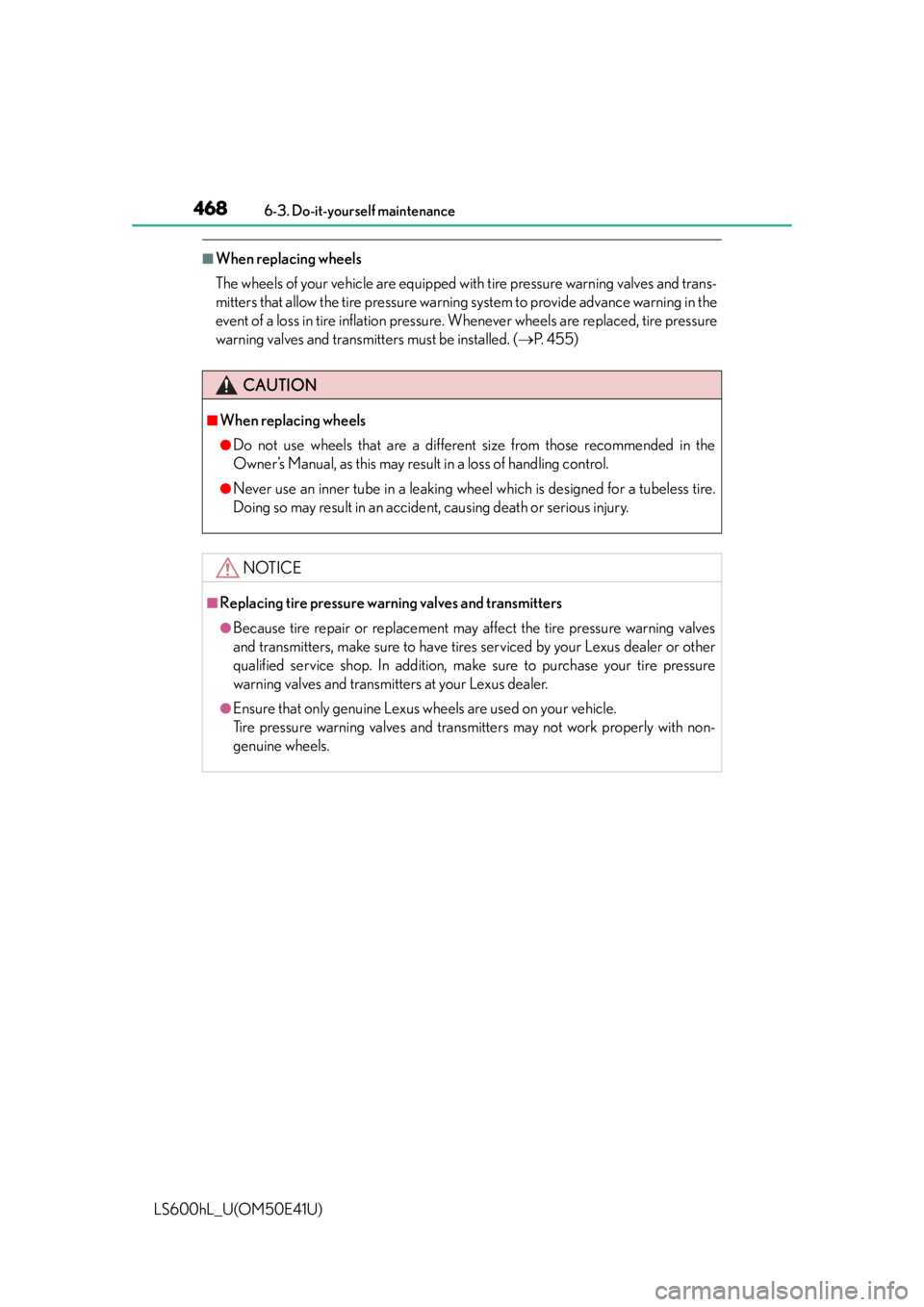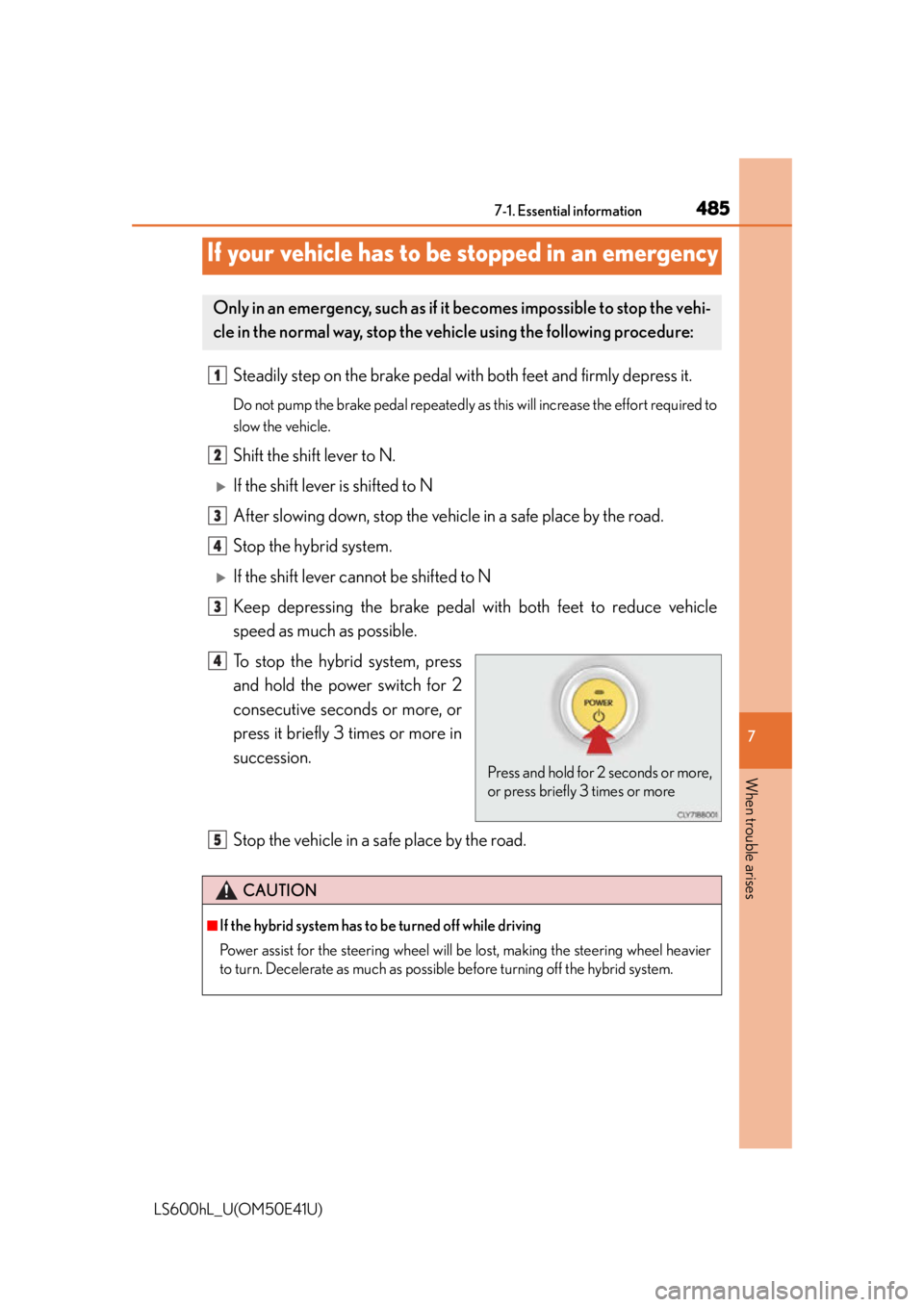Page 465 of 620

4636-3. Do-it-yourself maintenance
6
Maintenance and care
LS600hL_U(OM50E41U)
NOTICE
■Repairing or replacing tires, wheels, tire pressure warning valves, transmitters
and tire valve caps
●When removing or fitting the wheels, tires or the tire pressure warning valves and
transmitters, contact your Lexus dealer as the tire pressure warning valves and
transmitters may be damaged if not handled correctly.
●Make sure to install the tire valve caps. If the tire valve caps are not installed,
water could enter the tire pressure warning valves and the tire pressure warning
valves could be bound.
●When replacing tire valve caps, do not us e tire valve caps other than those speci-
fied. The cap may become stuck.
■To avoid damage to the tire pressu re warning valves and transmitters
When a tire is repaired with liquid seal ants, the tire pressure warning valve and
transmitter may not operate properly. If a liquid sealant is used, contact your Lexus
dealer or other qualified service shop as soon as possible. Make sure to replace
the tire pressure warning valve and transmitter when replacing the tire. ( P. 455)
■Driving on rough roads
Take particular care when driving on roads with loose surfaces or potholes.
These conditions may cause losses in tire inflation pressure, reducing the cushion-
ing ability of the tires. In addition, driving on rough roads may cause damage to the
tires themselves, as well as the vehicle’s wheels and body.
■If tire inflation pressure of each tire becomes low while driving
Do not continue driving, or your tires and/or wheels may be ruined.
Page 468 of 620

4666-3. Do-it-yourself maintenance
LS600hL_U(OM50E41U)
■Instructions for checking tire inflation pressure
When checking tire inflation pressure, observe the following:
●Check only when the tires are cold.
If your vehicle has been parked for at least 3 hours or has not been driven for more
than 1 mile or 1.5 km, you will get an accurate cold tire inflation pressure reading.
●Always use a tire pressure gauge.
It is difficult to judge if a tire is properly inflated based only on its appearance.
●It is normal for the tire inflation pressure to be higher after driving as heat is gener-
ated in the tire. Do not reduce tire inflation pressure after driving.
●Never exceed the vehicle capacity weight.
Passengers and luggage weight should be placed so that the vehicle is balanced.
CAUTION
■Proper inflation is critical to save tire performance
Keep your tires properly inflated.
If the tires are not properly inflated, the following conditions may occur which
could lead to an accident resulting in death or serious injury:
●Excessive wear
●Uneven wear
●Poor handling
●Possibility of blowouts resulting from overheated tires
●Air leaking from between tire and wheel
●Wheel deformation and/or tire damage
●Greater possibility of tire damage while driving (due to road hazards, expansion
joints, sharp edges in the road, etc.)
NOTICE
■When inspecting and adjusting tire inflation pressure
Be sure to put the tire valve caps back on.
If a valve cap is not installed, dirt or moisture may get into the valve and cause an air
leak, resulting in decreased tire inflation pressure.
Page 469 of 620

4676-3. Do-it-yourself maintenance
6
Maintenance and care
LS600hL_U(OM50E41U)
When replacing wheels, care should be taken to ensure that they are
equivalent to those removed in load capacity, diameter, rim width and
inset
*.
Replacement wheels are available at your Lexus dealer.
*: Conventionally referred to as “offset”.
Lexus does not recommend using the following:
●Wheels of different sizes or types
●Used wheels
●Bent wheels that have been straightened
●Use only Lexus wheel nuts and wheel nut wrenches designed for use
with your aluminum wheels.
●When rotating, repairing or changing your tires, check that the wheel
nuts are still tight after driving 1000 miles (1600 km).
●Be careful not to damage the alum inum wheels when using tire chains.
●Use only Lexus genuine balance wei ghts or equivalent and a plastic or
rubber hammer when balancing your wheels.
Wheels
If a wheel is bent, cracked or heav ily corroded, it should be replaced.
Otherwise, the tire may separate from the wheel or cause a loss of han-
dling control.
Wheel selection
Aluminum wheel precautions
Page 470 of 620

4686-3. Do-it-yourself maintenance
LS600hL_U(OM50E41U)
■When replacing wheels
The wheels of your vehicle are equipped with tire pressure warning valves and trans-
mitters that allow the tire pressure warnin g system to provide advance warning in the
event of a loss in tire inflation pressure. Whenever wheels are replaced, tire pressure
warning valves and transmitte rs must be installed. (P. 455)
CAUTION
■When replacing wheels
●Do not use wheels that are a different size from those recommended in the
Owner’s Manual, as this may result in a loss of handling control.
●Never use an inner tube in a leaking wheel which is designed for a tubeless tire.
Doing so may result in an accident, causing death or serious injury.
NOTICE
■Replacing tire pressure warning valves and transmitters
●Because tire repair or replacement may affect the tire pressure warning valves
and transmitters, make sure to have tires serviced by your Lexus dealer or other
qualified service shop. In addition, make sure to purchase your tire pressure
warning valves and transmitters at your Lexus dealer.
●Ensure that only genuine Lexus wh eels are used on your vehicle.
Tire pressure warning valves and transmitters may not work properly with non-
genuine wheels.
Page 487 of 620

4857-1. Essential information
7
When trouble arises
LS600hL_U(OM50E41U)
Steadily step on the brake pedal with both feet and firmly depress it.
Do not pump the brake pedal repeatedly as this will increase the effort required to
slow the vehicle.
Shift the shift lever to N.
If the shift lever is shifted to N
After slowing down, stop the vehicle in a safe place by the road.
Stop the hybrid system.
If the shift lever cannot be shifted to N
Keep depressing the brake pedal wi th both feet to reduce vehicle
speed as much as possible.
To stop the hybrid system, press
and hold the power switch for 2
consecutive seconds or more, or
press it briefly 3 times or more in
succession.
Stop the vehicle in a safe place by the road.
If your vehicle has to be stopped in an emergency
Only in an emergency, such as if it becomes impossible to stop the vehi-
cle in the normal way, stop the vehicle using the following procedure:
1
2
3
4
3
Press and hold for 2 seconds or more,
or press briefly 3 times or more
4
CAUTION
■If the hybrid system has to be turned off while driving
Power assist for the steering wheel will be lost, making the steering wheel heavier
to turn. Decelerate as much as possible before turning off the hybrid system.
5
Page 489 of 620
4877-2. Steps to take in an emergency
7
When trouble arises
LS600hL_U(OM50E41U)
Do not tow with a sling-type truck to
prevent body damage.
Towing with a sling-type truck
Towing with a wheel -lift type truck
From the frontFrom the rear
Use a towing dolly under the rear
wheels. Use a towing dolly under the front
wheels.
Page 490 of 620
4887-2. Steps to take in an emergency
LS600hL_U(OM50E41U)
If your Lexus is transported by a flat-
bed truck, it should be tied down at
the locations shown in the illustra-
tion.
If you use chains or cables to tie
down your vehicle, the angles
shaded in black must be 45.
Do not overly tighten the tie downs
or the vehicle may be damaged.
If a tow truck is not available in an emergency, y our vehicle may be tempo-
rarily towed using a cable or chain secured to the emergency towing eye-
let. This should only be attempted on hard surfaced roads for short
distances at low speeds.
A driver must be in the vehicle to steer and operate the brakes. The vehi-
cle’s wheels, drive train, axles, steeri ng and brakes must be in good condi-
tion.
Using a flatbed truck
Emergency towing
Page 491 of 620
4897-2. Steps to take in an emergency
7
When trouble arises
LS600hL_U(OM50E41U)
Take out the towing eyelet. (P. 507, 516)
Remove the eyelet cover using a
flathead screwdriver.
To protect the bodywork, place a rag
between the screwdriver and the vehi-
cle body as shown in the illustration.
Insert the towing eyelet into the
hole and tighten partially by hand.
Tighten down the towing eyelet
securely using a wheel nut
wrench or hard metal bar.
Securely attach a cable or chain to the towing eyelet.
Take care not to damage the vehicle body.
Enter the vehicle being towed and start the hybrid system.
If the hybrid system does not start, turn the power switch to ON mode.
Shift the shift lever to N and release the parking brake.
When the shift lever cannot be shifted: P. 5 1 9
Emergency towing procedure
1
2
3
4
5
6
7